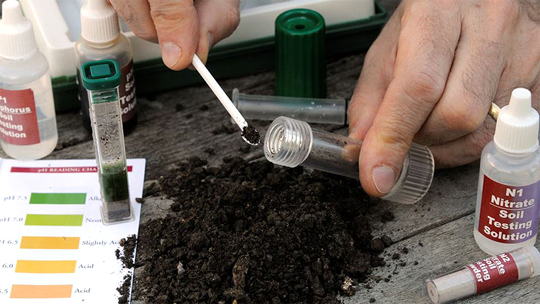Soil Testing & Investigation Laboratory
Soil Testing & Investigation

Soil Testing and Analysis is a process in which nutrients, elements, contaminants, pH and acidity is checked by sampling and testing in laboratory for Agricultural or Construction purpose.
Soil Pollution
The soil pollution or soil contamination is defined as the presence of materials in the soil which are harmful to the living beings when they cross their threshold concentration levels. It is cause by Industrial activity, Agricultural Chemicals, Fertilizers (Excess use) or improper disposal of waste.
What Causes Soil Pollution?
Industrial wastes such as harmful gases and chemicals, agricultural pesticides, fertilizers and insecticides are the most common causes of soil pollution or soil contamination. Improper septic system and management and maintenance of the same. Leakages from sanitary sewage. Acid rains, when fumes released from industries get mixed with rains. Fuel leakages from automobiles, that get washed away due to rain and seep into the nearby soil. Unhealthy waste management techniques, which are characterized by release of sewage into the large dumping grounds and nearby streams or rivers.
What are the Effects of Soil Pollution?
Decrease in soil fertility and therefore decrease in the soil yield. How can one expect contaminated soil to produce healthy crops? Loss of soil and natural nutrients present in it. Plants also would not thrive in such soil, which would further result in soil erosion. Foul smell due to industrial chemicals and gases might result in headaches, fatigue, nausea, etc., in many people. Creation of toxic dust is another potential effect of soil pollution.
Soil Sample Collection
Soil sample collection is the most important & critical step in soil analysis. There are two ways of collecting soil samples. Collection of soil sample is depending on size of field and uniformity.
1. Grab Sampling
In this method, Soil sample is collected randomly from field. This method is suitable for the fields which are small in size and uniform. This is a most common & economic method used in soil analysis.
2. Composite sampling
In this method more than one sub samples mixed for sampling field. Generally, this type of method is suitable for larger & non-uniform fields. In this sampling method preferebally 15 to 25 sub samples are collected for best result. Also deeper samples may be collected for subsoil analysis. After soil sampling collection sample is placed in clean plastic bucket & mixed completely. After that desired sample amount is removed from that bucket & let it dry for 2-3 days. After that it is sent to laboratory for the further Soil testing.
Soil Testing in Laboratory
Soil testing is carried out in our analytical laboratory for following parameters:
- pH
- Residual Chlorine
- Chloride as Cl-Sulphate as SO4
- Phosphate as PO4
- LOD @ 105 degree CLOI @ 550 degree C
- Flash Point
- Calorific Value
- Specific Gravity
- Arsenc as As
- Cadmium as Cd
- Cobalt as Co
- Copper as Cu
- Chromium as Cr
- Lead as Pb
- Mercury as Hg
- Nickel as Ni
- Zinc as Zn
- Organic Matter
Copyright © ENVIROTECH RESEARCH PVT. LTD. 2017 All Rights Reserved Designed by : Ameya Computers
